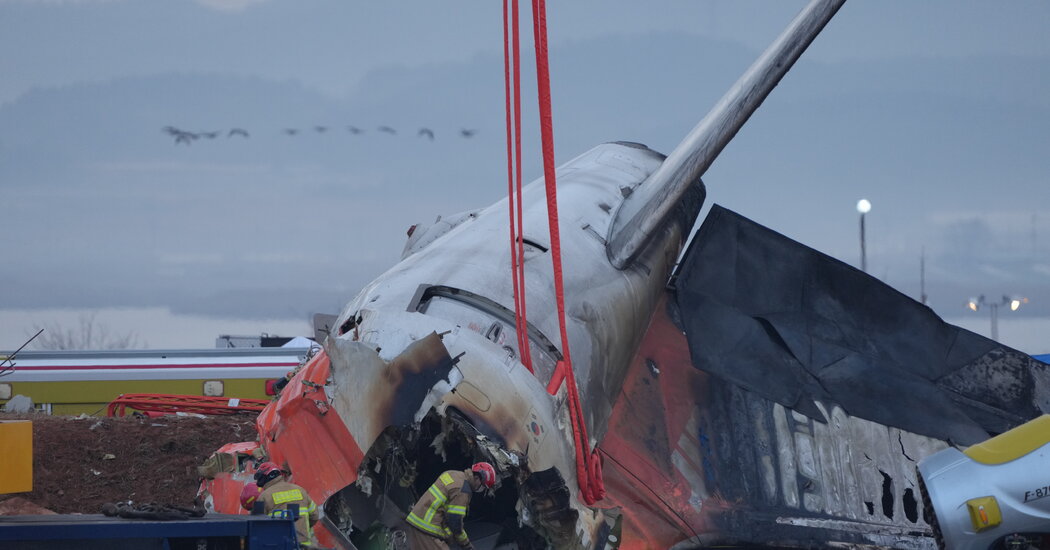The last warning took place ten days before the deadliest air accident in South Korea.
A dozen officials gathered inside a room at Muan International Airport for a bird strike prevention committee, which discussed the number of bird -affected planes, with data that show an incident leap for the last two years.
One of the officers, from one of the country’s aviation training institutes, expressed concern that planes reaching the earth often encountered herds of birds by the coast, according to a register of the meeting obtained by a legislator. To what extent is it possible to move the birds away? asked the official.
The answer was not calm. There were not enough people and cars deployed at the airport to keep the birds away and the sounds of the speakers used to emit noise to scare the birds were not strong enough to get enough beyond the airport, said a company official who managed the airport facilities. He said that they were « trying the best possible. »
Then, on December 29, the pilot of Jeju Air Flight 2216 declared « Mayday! Mayday! Mayday! » And he told the air traffic controllers that there was a bird strike, as the plane was down. After a sharp turn, the ray landed on the belly, went down the track and put in a concrete barrier, exploiting in a fireball that killed 179 of the 181 people on board.
The researchers have not identified the reasons for the fall and what role, if any, could have played a bird strike. But the country’s Ministry of Transportation said that feathers and blood were found in the two engines of the JET. The remains were identified as Teal Baikal, a migratory duck in South Korea in winter, which often flies in herds of up to tens or even hundreds of thousands.
The December 19 meeting was not the first warning that the airport operators had received on birds. The dangers had been marked for decades, even before Muan Airport opened in 2007, according to an examination of the New York Times of thousands of government documents, interviews with dozens of people and a visit to the wetlands surrounding the south -west airport. Environmental evaluations in 1998 and 2008 also said that there were many bird species that lived near the airport.
The clearest, in 2020, when the airport began reforms that would include the extension of its runway, the South Korea’s environmental impact assessment service said that there was « a high risk of bird strike during takeoff and landing. » He advised that measures were needed to reduce the risk.
The Korea Aeroports corporation said in response to questions from the times that to prevent bird strikes had used vehicles and noise manufacturers to disperse herd herds, and that he had conducted environmental surveys to control the surrounding airport habitats. The company said that more speakers were installed at the airport facilities after the December 19 meeting.
But, like most smaller airports in South Korea, Muan still lacked thermal image cameras and bird detection radar that were used to alert air traffic drivers and pilots to the presence of birds, according to the government.
Airports are recommended that these measures are underway, according to the guidelines of the International Civil Aviation Organization, a United Nations Agency that establishes world standards for the aviation industry.
« The regulations are there, but people have been breaking them without repercussions, » says Dr. Nial Moores, the National Director of Korea de les Birds, a bird conservation group. « They were warned about the risk of a bird strike, » he added. « How has anything changed? »
In addition to not following international guidelines, the airport operators also violated domestic security rules.
On the day of the fall to Muan, only one person was on the service of taking into account birds, instead of a minimum of two who require the rules of the Government, according to the legislators in a parliamentary committee who listened to the disaster.
That bird pattern was at the end of a 15-hour night shift, the period in which the vast majority of bird strikes occur, according to a presentation by Moon Geum-Joo, a legislator, in the view of the Committee. Joo Jong-Wan, the head of the Aviation Policy of the Ministry of Transport, acknowledged that the airport patrol was fastened and said that all airports would fulfill the minimum staff in the future.
The Korea Airports corporation said that it had joined the government rules and hired more staff to prevent bird collisions. The Ministry of Transport refused to comment.
In addition, at least one person needed to attend the meeting of the Bird Strike Prevention Committee had lost that of December 19, an official of the Corea Airports Corporation corporation recognized in parliamentary view. The state company operates almost all South Korea airports, including Muan.
« It is a shame that they have known about their shortcomings for years, but in fact nothing has been done to improve, » said Kwon Hyang-Yup, an opposition legislator who obtained the report from the Bird Security Committee.
While the aircraft hits with Wildlife is not rareMost do not make the planes crash. Of about 20,000 wildlife strikes in the United States in 2023, about 4 percent caused damage to the plane.
Since the fall, the South Korea government has pledged to 247 billion gains (about $ 170 million) for three years to improve measures to prevent bird hike at all airports in the country. The planned measures include the installation of bird detection devices and the implementation of a national radar model to alert people to the control towers, the patrulators on the ground and the pilots in the presence of birds.
Some experts ask if Muan Airport should have been built at all due to the abundance of birds in the wetlands that surround it. The airport has reported at least twice the largest number of bird strikes from the country’s 15 airports for the last five years, with six cases in 2024, up to two of the previous year.
Its bird strike rate was ten times that of Incheon’s International Airport, the largest in the country, according to data published by Ms. Kwon, the legislator. Incheon, also near bird habitats, has been identified Almost 100 species of birds around their surroundings. It has four thermal image cameras, two devices that emit bird repetition noises and 48 workers assigned to bird control, according to a representative of the airport.
Ju Yung-Ki, researcher and conservationist who has visited the Muan area repeatedly in recent years, worked at his office on December 29 when he met the clash on the plane.
« He had always thought that there was a bird strike risk, » said Mr. Ju, the director of the Ecoculture Institute. Mr. Ju had flown and left Muan Airport several times, despite his concerns.
After listening to news of the accident, he turned about 70 kilometers from his house in Jeonju, north -east of Muan, to a lake near the airport and reached 16.30, he could see the carbonized queue on the plane and the wreck at the end of the court. « It was horrible, » he said, adding that he spilled tears, thinking of the people who had died.
As he progressed that afternoon, he also found herds of up to 300,000 Baikal theals about 18 kilometers from the airport. He flies at least this distance to look for food, and observed with Binocles and a telescope that the airport was on his daily flight path.
The Baikal TEAL is not particularly large, about 16 inches long with a wingspan of eight inches. But the ducks move in large agile herds, which can reach a million in number, said Dr. Moores of Birds Corea. It is raised in Siberia and reach the southern coast -west of South Korea in October and remain until early March.
Muan, almost 200 kilometers south of Seoul, is between the pastures and the marshy reservoirs of the South Peninsula -west, where the duck and other species of birds climb in the quiet water pockets. Local business owners said bird herds were more often in a field club near the airport; Four miles away.
A regulation of execution attached to the law of the South Korea Airport facilities in 2017 stipulates that an airport cannot be built at eight kilometers, or about five kilometers, of a bird sanctuary or reserve. But, according to the Nation’s Ministry of Environment, there is only one sanctuary in Muan and is located about 12 kilometers from the airport.
Conservationists say that reality is different. They say that the term sanctuary, classified as a collective habitat and a breeding ground for endangered wildlife, ignores many of the villages of bird habitats in the region. A map of the Civil Aviation Office Identify four areas that surround Muan Airport where the birds are feeding on.
Some of these points are so close to a mile from the airport. One morning February, hundreds of birds flew over this distance. The largest birds flew in a « V » formation, while the smallest ones got and went out in an aerial dance.
« This is not whether Muan International Airport is near a shrine, » said Ju. « The fact is that there are many birds that live there. »
The decision on whether an area is a sanctuary falls on the Mayor or governorAccording to the Law of Protection and Management of South Korea’s wildlife. There are about 400 of these areas protected throughout the country, according to the Ministry of the Environment.
Experts say that no matter how bird strikes are not completely eliminated. « What is obvious is not to build an airport where there are many birds, » said Keith Mackey, an expert in North -American Aviation and Security Consultant based in OCALA, FLA.
Other methods that could be deployed to deter birds include the use of brightly colored paint on the court and drones to disperse nearby herds, said Mackey.
Muan Airport has closed since the fall of December 29 and will not resume commercial flights until April 18 to the sooner. The airport recently resumed medical and training flights.
South Korea has ambitious plans to build ten airports in the coming decades in response to booming regional demand to increase travel abroad. Several will also be along the western coast. One is special for conservationists: a SaemangeumAbout 65 kilometers north of Muan.
The proposed airport, which is scheduled to open in 2029, is four kilometers from the Seocheon Tidal floor, a UNESCO heritage that houses dozens of nationally protected wildlife species, including birds, according to Kim Nahee, an activist protest against the construction of the new airport.
Officials in the North Jeolla province, where Saemaneum is located, said that « there were no infrastructures that annoyed the flight path of birds », quoting an analysis he had received from the analysis of the Environmental Agency of the Government.
« They should not have built Muan International Airport where they did so, » said Mrs. Kim. « This cannot happen again. »












Leave a Reply